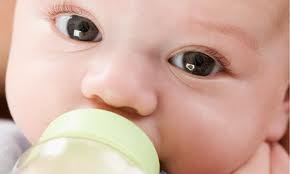After your baby is born, you must be able to feed him with enough sustenance outside of your body. Because the umbilical cord is already severed, you are now responsible to provide all the essential vitamins and minerals that your baby needs to grow and develop. What better to feed your baby than milk? It can either be breast milk or milk formula. Breast milk is undeniably the best but if you decide to bottle feed your baby, a formula with a cow’s milk base is the optimal choice. You should always remember that the formula you give to your baby should be prescribed by your pediatrician.
In bottle feeding babies, you have three forms of formula to choose from—powdered preparation, pre-mixed, and liquid concentrate. Among these three, powdered preparation is the least expensive and pre-mixed formula is the most expensive. A lactose-free milk formula should be given if your baby is lactose-intolerant. Here are some pointers that you have to consider in bottle feeding babies:
1. Note the nutrients
 Bottle feeding babies can be rewarding when you think about the nutrient content of the milk formulas. They usually contain fat, proteins, vitamins ( D, A, C, K, E), calcium, and iron among other nutritional ingredients.
Bottle feeding babies can be rewarding when you think about the nutrient content of the milk formulas. They usually contain fat, proteins, vitamins ( D, A, C, K, E), calcium, and iron among other nutritional ingredients.
2. Formula preparation
 When you start bottle feeding babies, you should always read the directions indicated in the packaging. You should make this a habit to make sure that the milk formula you give is of the right amount that is age-appropriate. To be sure, you should always boil the water for one minute that you use to prepare the formula. Cool it down first. After combining the milk formula with the pre-boiled water, shake it well. You could keep it refrigerated for about twenty-four hours.
When you start bottle feeding babies, you should always read the directions indicated in the packaging. You should make this a habit to make sure that the milk formula you give is of the right amount that is age-appropriate. To be sure, you should always boil the water for one minute that you use to prepare the formula. Cool it down first. After combining the milk formula with the pre-boiled water, shake it well. You could keep it refrigerated for about twenty-four hours.
3. Choosing the nipple and bottle
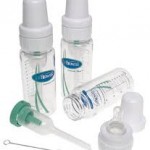 Baby bottles can be made of glass and plastic. They could also be disposable. In bottle feeding babies, it is important for you to choose the best quality of bottles and nipples so that you may be able to use them for a long period of time. Make sure that the bottles you choose has no cracks or protruding chips that may harm you or your baby. Nipples used can be silicone, later, or rubber. You could consult your pediatrician about the best kind but you could also try them each so that you may know what your baby prefers. Replace the nipple already if there is too much milk flowing out of it, if it is discolored, and if it is deformed or deteriorated.
Baby bottles can be made of glass and plastic. They could also be disposable. In bottle feeding babies, it is important for you to choose the best quality of bottles and nipples so that you may be able to use them for a long period of time. Make sure that the bottles you choose has no cracks or protruding chips that may harm you or your baby. Nipples used can be silicone, later, or rubber. You could consult your pediatrician about the best kind but you could also try them each so that you may know what your baby prefers. Replace the nipple already if there is too much milk flowing out of it, if it is discolored, and if it is deformed or deteriorated.
4. Sterilizing
 Sterilization is very important in bottle feeding babies. This process is for the bottles and the nipples that should run for five minutes. You should cool the bottle before using it. Remember that the nipples will always change their color when they are boiled. This doesn’t mean that they are damaged. Bottle liners equipped with holder are also available for your baby.
Sterilization is very important in bottle feeding babies. This process is for the bottles and the nipples that should run for five minutes. You should cool the bottle before using it. Remember that the nipples will always change their color when they are boiled. This doesn’t mean that they are damaged. Bottle liners equipped with holder are also available for your baby.
5. Warming
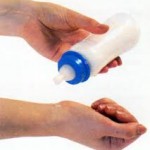 Warming milk bottles when bottle feeding babies, should not include using the microwave. You will risk subjecting the bottle and nipple to damage. Also, you and your baby might suffer from burns. You should place the prepared formula in boiling water first before you feed it to your baby. You could also have an option of getting a deep bowl or measuring cup and filling it with boiling water. Then, place the cool bottled formula in that hot water for about two minutes until the bottle is a bit lukewarm. Swirl or shake the bottle to even out the temperature. Place a few drops of the warmed up milk on the inner part of your wrist to test if it’s just all right.
Warming milk bottles when bottle feeding babies, should not include using the microwave. You will risk subjecting the bottle and nipple to damage. Also, you and your baby might suffer from burns. You should place the prepared formula in boiling water first before you feed it to your baby. You could also have an option of getting a deep bowl or measuring cup and filling it with boiling water. Then, place the cool bottled formula in that hot water for about two minutes until the bottle is a bit lukewarm. Swirl or shake the bottle to even out the temperature. Place a few drops of the warmed up milk on the inner part of your wrist to test if it’s just all right.
6. Storage
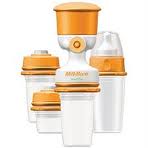 You could store your prepared milk formulas in the fridge for about twenty four hours. The milk that is left-over after a single feeding should ideally be disposed and never be given to your baby after hours of standing.
You could store your prepared milk formulas in the fridge for about twenty four hours. The milk that is left-over after a single feeding should ideally be disposed and never be given to your baby after hours of standing.
7. How much
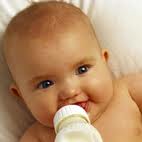 In bottle feeding babies, you should remember to feed your baby two to three ounces of the formula for each feeding. Babies usually eat every two to three hours. On the first month, four ounces will be consumed every three hours. It is only expected that the amount of milk formula will increase as the baby grows. The flow rate of the nipple will also change as your baby grows. During the earlier months, the flow rate is one drop per second.
In bottle feeding babies, you should remember to feed your baby two to three ounces of the formula for each feeding. Babies usually eat every two to three hours. On the first month, four ounces will be consumed every three hours. It is only expected that the amount of milk formula will increase as the baby grows. The flow rate of the nipple will also change as your baby grows. During the earlier months, the flow rate is one drop per second.
Bottle feeding babies can be very hard especially if it is your first baby. Allergic reactions and lactose intolerance may occur that is why you should maintain constant communication with your pediatrician. Allergy symptoms are rashes, vomiting, and diarrhea. Lactose intolerance may be manifested through abdominal pain and gas. You could usually switch to whole milk by the time your baby turns one. Whole milk has all the essential nutrients that your baby needs to develop well.
